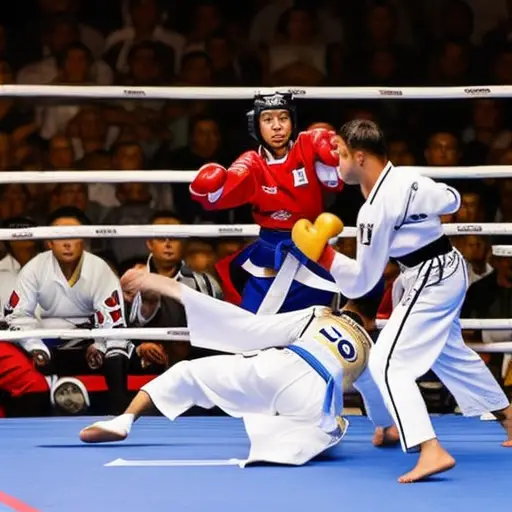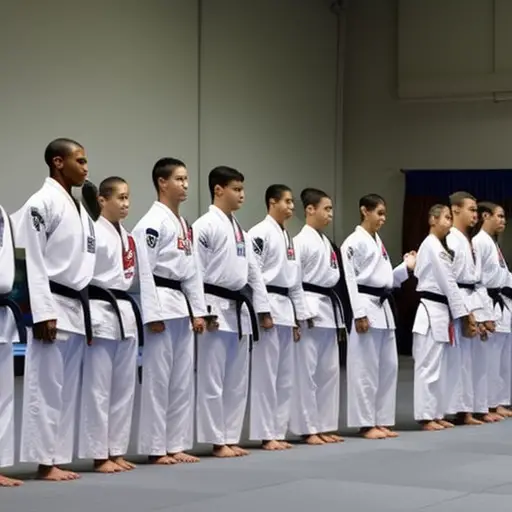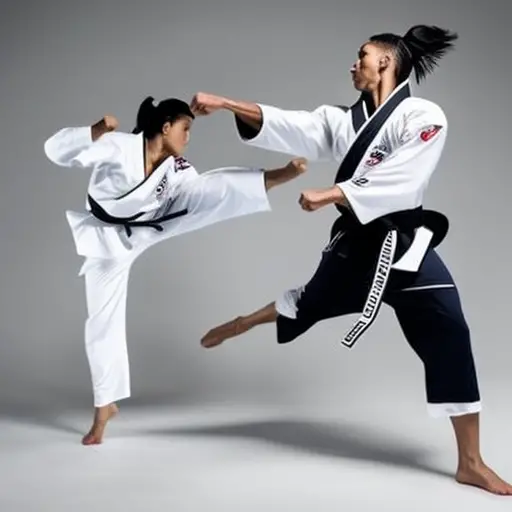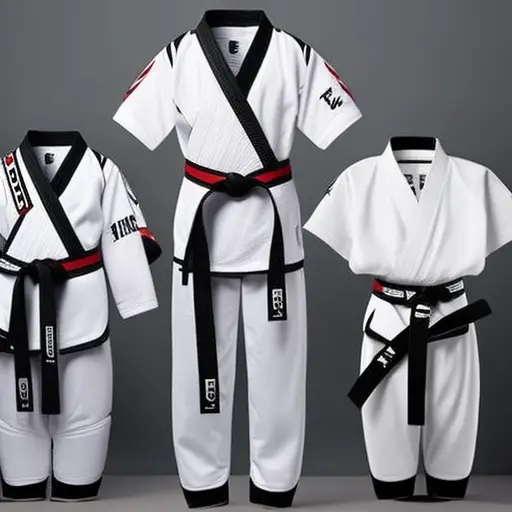Understanding the Rules of Taekwondo Competition

In the world of taekwondo competition, knowledge of the rules is akin to a guiding compass, directing athletes towards victory.
This article aims to provide a comprehensive understanding of the intricate regulations governing taekwondo matches.
From the scoring system, weight classes, and legal techniques to penalties, time limits, and equipment regulations, this guide will equip aspiring competitors with the necessary knowledge to navigate the complex world of taekwondo competition with confidence and precision.
Scoring System in Taekwondo Competition
The scoring system in Taekwondo competition is an essential component that determines the allocation of points based on successful techniques and strikes. It is crucial to understand how this system works to accurately assess the performance of the competitors.
Taekwondo follows a point-based scoring system, where each successful strike or technique is awarded a specific number of points. The scoring is done electronically with sensors placed on the competitors’ protective gear and the scoring area. These sensors detect and register valid strikes, kicks, punches, and other techniques.
In addition to this, Taekwondo also employs a challenge system, which allows competitors or their coaches to challenge the decision of the referee. This system provides a fair chance to rectify any potential errors in scoring.
In case of a tie during a match, tie breaker rules are implemented. These rules vary depending on the competition level and may include additional rounds or specific techniques to determine the winner.
Now that we have a clear understanding of the scoring system, let’s move on to the next section, which discusses the weight classes and divisions in Taekwondo competition.
Weight Classes and Divisions
With the aim of promoting fair competition, taekwondo competitions are divided into weight classes and divisions, ensuring that opponents are matched based on their similar physical characteristics. The use of weight classes in taekwondo is crucial to maintain an equal playing field and prevent unfair advantages due to size or strength discrepancies. Taekwondo practitioners are grouped into different weight categories, allowing them to compete against opponents of similar size and weight.
The weight classes in taekwondo vary depending on the competition level and governing body. Typically, there are several divisions, ranging from lightweight to heavyweight. Each division has a specific weight range, and participants must fall within those limits to compete in that particular category. This ensures that competitors are evenly matched and have a fair chance of success.
Weight classes also play a significant role in the competition rules of taekwondo. They determine the eligibility of participants for certain events and regulate the outcome of matches. In most competitions, if a competitor does not make weight for their designated division, they may be disqualified or asked to move up to a higher weight class.
Legal Techniques and Targets in Taekwondo
In Taekwondo competition, points are awarded for successful techniques that are executed on the approved striking areas of the body. These areas include the torso, head, and face.
However, certain techniques and targets are disallowed, such as strikes below the waist, to the back, or to the joints.
Understanding the approved techniques and targets is crucial for competitors to score points effectively and comply with the rules of Taekwondo competition.
Approved Striking Areas
To ensure fair and standardized competition, it is important for taekwondo practitioners to understand the approved striking areas, which dictate the legal techniques and targets in this martial art.
In taekwondo, only certain areas of the body are considered legal targets for strikes, known as the approved striking areas. These include the torso, both front and sides, as well as the head. Strikes to these areas are allowed and can score points in competition.
However, there are also prohibited strikes in taekwondo, such as strikes to the groin, back of the head, throat, and joints. These strikes are considered dangerous and can result in penalties or disqualification.
Understanding the approved striking areas and prohibited strikes is crucial for taekwondo practitioners to compete effectively and safely.
Now let’s move on to discussing the disallowed techniques and targets.
Disallowed Techniques and Targets
Significantly, taekwondo competition strictly prohibits the use of certain techniques and targets to ensure the safety and integrity of the sport. These disallowed techniques are considered too dangerous or unfair, and their use can result in penalties or disqualification.
The prohibited targets in taekwondo are areas of the body that are considered too vulnerable or dangerous to strike. Here are three categories of disallowed techniques and prohibited targets in taekwondo:
-
Head strikes: Direct strikes to the head with kicks or punches are not allowed in taekwondo competitions due to the risk of serious injury.
-
Groin strikes: Any intentional strikes to the groin area are strictly prohibited as they can cause severe pain and damage.
-
Back strikes: Striking the back is not allowed in taekwondo as it can lead to spinal injuries.
Adherence to these rules ensures the safety and fairness of taekwondo competitions, making it a respected martial art and sport.
Penalties and Disqualifications in Taekwondo Competition
One common consequence in taekwondo competitions is the issuance of penalties or disqualifications. These penalties are imposed on athletes who violate the rules and regulations set forth by the governing bodies of the sport. The enforcement of these penalties is essential to maintain fairness and ensure the safety of all participants.
When a competitor commits a foul or engages in unsportsmanlike conduct, they may face various forfeiture consequences. These penalties can range from point deductions to disqualification from the match or even the entire competition. The severity of the penalty depends on the seriousness of the offense and may be determined by the referee or a panel of judges.
Penalties can be imposed for a variety of reasons, including excessive contact, intentional fouls, or prohibited techniques. For instance, if a competitor uses an illegal strike, such as hitting below the belt or attacking the opponent’s back, they may be penalized. Additionally, unsportsmanlike behavior, such as disrespecting the opponent or the officials, can also result in penalties.
The enforcement of penalties and disqualifications is crucial to maintain the integrity of taekwondo competitions. It ensures that all participants adhere to the rules and compete in a fair and respectful manner. The penalties serve as a deterrent and encourage athletes to display good sportsmanship and adhere to the established rules and regulations.
Time Limits and Rounds in Taekwondo Matches
The duration of taekwondo matches is determined by the time limits and the number of rounds, providing structure and ensuring fairness in the competition.
Taekwondo matches are divided into three rounds, with each round lasting two minutes for senior athletes and one minute for junior athletes. The rounds are separated by a one-minute break, allowing competitors to catch their breath and strategize for the next round.
Here are some key points about round structure and overtime rules in taekwondo matches:
-
Round Structure:
-
Each round consists of three minutes of active competition.
-
The clock stops when the referee issues a command, when a competitor scores a point, or when there is a medical timeout.
-
The competitor who scores the most points during each round wins the round.
-
Overtime Rules:
-
If the match ends in a tie after three rounds, an additional round known as ‘Golden Point’ is conducted.
-
The first competitor to score a point during this round wins the match.
-
If no points are scored during the ‘Golden Point’ round, the winner is determined by superiority, which takes into account factors such as aggression, technique, and tactical skills.
With the time limits and round structure in place, taekwondo matches are carefully regulated to ensure fair competition and an exciting spectator experience.
Now, let’s delve into the next section and explore the equipment and attire regulations in taekwondo.
Equipment and Attire Regulations in Taekwondo
In order to maintain consistency and safety during taekwondo competitions, strict regulations are enforced regarding the equipment and attire used by participants. These regulations ensure that all competitors are properly equipped and dressed, allowing them to perform at their best while minimizing the risk of injury.
Protective gear is an essential component of taekwondo competition. It not only protects the participants from potential injuries but also ensures fair play. The most important piece of protective gear is the headgear, which is designed to cushion blows to the head and reduce the risk of concussions. In addition to headgear, competitors are also required to wear a mouthguard to protect their teeth and gums, as well as a groin protector for male participants.
Uniform guidelines in taekwondo are strict and specific. Competitors must wear a dobok, a traditional taekwondo uniform consisting of a jacket and pants. The jacket is usually white, while the pants can be either white or black. The uniform must be clean and in good condition, with no tears or patches. Competitors are also required to wear a belt of the appropriate color, indicating their rank in the sport.
These regulations regarding equipment and attire are enforced to ensure fairness and safety for all participants in taekwondo competitions. By following these guidelines, competitors can focus on their technique and skill, while judges and officials can ensure a fair and level playing field.
Strategies and Tactics in Taekwondo Competition
When it comes to strategies and tactics in Taekwondo competition, understanding effective kicking techniques is crucial.
Points are awarded for clean, well-executed kicks to specific target areas, such as the head or body.
Additionally, defensive maneuvers and counters play a vital role in gaining points by successfully blocking or evading an opponent’s attack.
Lastly, the importance of footwork cannot be underestimated, as it allows fighters to maintain balance, create openings, and execute powerful kicks with precision.
Effective Kicking Techniques
An effective kicking technique is a crucial aspect of a taekwondo competitor’s strategy and can significantly impact the outcome of a match. Taekwondo is known for its dynamic and powerful kicks, and mastering these techniques is essential for success in competition. Here are three key kicking strategies and tactics that taekwondo athletes employ:
-
Spinning kicks: These advanced techniques involve rotating the body and striking the opponent with precision and speed. Spinning kicks, such as the spinning hook kick and spinning back kick, are effective for surprising opponents and creating scoring opportunities.
-
Jumping kicks: Jumping kicks, like the flying side kick and flying front kick, allow competitors to cover a greater distance and generate more power. These techniques are often used to score points against taller opponents or to break through a strong defense.
-
Combination kicks: Combining different kicks in rapid succession is a strategic way to confuse and overwhelm opponents. By seamlessly transitioning from one kick to another, taekwondo athletes can keep their opponents off balance and create openings for scoring.
Mastering these kicking techniques requires precision, timing, and flexibility. Practice and repetition are key to developing the necessary skills to execute these kicks effectively in taekwondo competitions.
Defensive Maneuvers and Counters
With a focus on maintaining balance and minimizing the opponent’s scoring opportunities, taekwondo competitors employ various defensive maneuvers and counters to strategically neutralize their opponents’ attacks.
Defensive strategies play a crucial role in taekwondo competition, as they allow practitioners to protect themselves while creating opportunities for counterattacks.
One common defensive maneuver is the ‘block,’ where competitors use their arms or legs to intercept and redirect incoming strikes. By using precise timing and positioning, taekwondo practitioners can effectively defend against their opponent’s attacks.
Additionally, footwork plays a vital role in defensive strategies, as it allows competitors to evade strikes and maintain their balance.
Once the opponent’s attack has been successfully defended, taekwondo practitioners can launch counterattacks, using their speed and agility to strike back and score points.
These defensive maneuvers and counterattacks are crucial components of taekwondo competition, requiring skill and strategic thinking to execute successfully.
Importance of Footwork
Proper footwork is an essential aspect of taekwondo competition, as it allows competitors to effectively execute strategies and tactics during matches. Agility and balance are key components of footwork that enable athletes to maneuver swiftly and maintain stability while executing their techniques.
Here are three important reasons why footwork is crucial in taekwondo competition:
-
Agility: Quick and nimble footwork enables competitors to swiftly evade attacks and create openings for their own offensive moves. It allows them to change positions rapidly, making it difficult for their opponents to anticipate their next move.
-
Balance: Maintaining a stable and balanced stance is vital in taekwondo. Proper footwork helps athletes distribute their weight evenly, providing a solid foundation for powerful kicks and punches. It also ensures that they can quickly recover their balance after executing an attack or defending against one.
-
Tactical Advantage: Effective footwork allows competitors to control the distance between themselves and their opponents. By strategically moving in and out of range, they can exploit weaknesses in their opponent’s defense, launch surprise attacks, or lure them into making mistakes.
Frequently Asked Questions
Are There Any Restrictions on the Use of Protective Gear in Taekwondo Competition?
Restrictions on protective gear in taekwondo competition aim to strike a balance between safety and performance. While certain gear is mandatory, restrictions are in place to prevent excessive padding that could hinder agility and limit effective strikes.
How Are Tiebreakers Handled in Taekwondo Matches?
In the realm of taekwondo competitions, the resolution of tiebreakers holds significant importance. Understanding the intricacies and protocols involved in handling tiebreakers ensures fairness and accuracy in determining the victor.
Can a Competitor Change Weight Classes or Divisions During a Competition?
Competitors in Taekwondo competitions are not allowed to change weight classes or divisions during a competition. The rules and regulations of the sport have strict restrictions regarding such changes to ensure fair and equal competition.
Are There Any Specific Rules Regarding the Use of Kicks in Taekwondo Matches?
Kicking techniques play a significant role in taekwondo matches, with various scoring criteria determining the effectiveness and value of each kick. These rules ensure that competitors utilize their skills and strategies to gain an advantage in the competition.
What Are the Guidelines for Determining the Winner in Case of a Technical Issue or Equipment Malfunction During a Match?
In case of technical issues or equipment malfunction during a taekwondo match, the guidelines for determining the winner vary depending on the specific circumstances. The decision is typically made by the referee or the competition officials.
Conclusion
In conclusion, understanding the rules of taekwondo competition is crucial for both participants and enthusiasts.
By familiarizing oneself with the scoring system, weight classes, legal techniques, penalties, time limits, and equipment regulations, individuals can fully engage in the sport with confidence and precision.
The strategic and tactical aspects of taekwondo further enhance the overall competition experience, allowing athletes to showcase their skills in a controlled and disciplined manner.
Mastery of these rules and regulations is essential for success in taekwondo competition.





